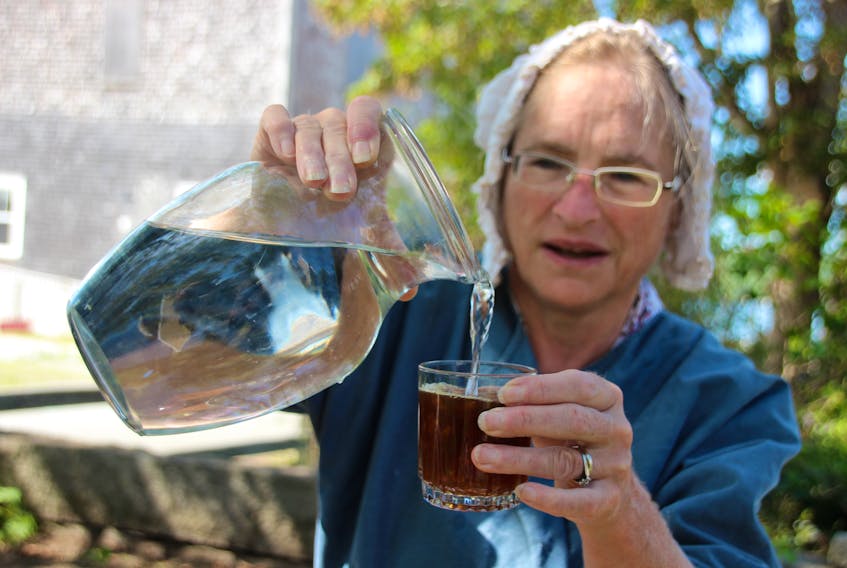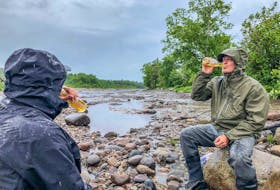“This is switchel, the 18th-century sports drink,” says Greta Mossman.
She’s mixing the mysterious elixir in the garden at the Ross-Thomson House and Store Museum in Shelburne, N.S. She pours a brown liquid from a teapot of the same colour into a clear glass. For a moment, she drops her act as pioneer housewife.
“It’s their version of Gatorade.”
She hands me the glass. It smells like vinegar. I take a sip and stop there because it tastes like it smells.
While recipes vary, Mossman adds ingredients readily available in the 18th century like ginger and lots of sweeteners – molasses, brown sugar, honey – to balance the cider vinegar.
Dressed in period-accurate blue petticoat, pink short gown, and white cap, Mossman is the museum’s senior interpreter. In her role, she’s researched switchel and found it has a colourful history - parts of it as dark as its colour.
“It was used as a substitute for rum rations on British Navy ships,” Mossman says.
Given that the Ross-Thomson store supplied many such ships, early Shelburne residents and visitors were probably well acquainted with the tart refreshment.
“If you added rum, it was grog. The vinegar is to thin your blood and keep your circulation going. It’s high in iron and vitamin C.”
She says vinegar was a substitute for lime juice, both of which prevented scurvy.
“It’s also called haying water,” Mossman says, adding that her recipe is based on one from George Washington’s diaries. While he fed it to his troops, he and others prepared it for their slaves at work in the fields.
“They were your property, so you didn’t want people collapsing with heat stroke. This recipe was used to rehydrate, and it balances your electrolytes. It has everything you need.”
Experience Heritage

The Ross-Thomson House and Store – just one of the heritage buildings that make up Museums by the Sea on historic Dock Street – is restored to the 1780s, a period when thousands of Loyalists and Black Loyalists flooded the rough settlement cut out of the wilderness.
From their store, brothers George and Robert Ross used the suddenly bustling port to carry on international trade in tea, wine, rum, and other drinks.
Switchel is, thankfully, just one of several period drinks Mossman whips up for visitors. While others are dipping beeswax candles and hand spinning wool with a drop spindle here in the museum’s garden, Mossman tells me how she’s tested earlier techniques for making lemonade to see how they stack up against contemporary recipes.
She’s tried fresh squeezed lemons and lemon juice concentrate. She’s also tried plain citric acid, which she says, “people use for pickling or as an agent for dying clothing.”
Mixing it with water and sugar was once the preferred method of making lemonade.
“It was considered the cotton candy of the 18th century,” she says, adding that it was nicknamed “fairground lemonade” because kids brought their own mugs to the fair and filled them up with the sweet treat. When she organized a taste test of all three, the fairground variety came out the winner.
Mossman makes hot drinks as well.
“We’ve done a dandelion root coffee,” she says.
Preparing the drink involves many more steps than the lemonade. After harvesting the roots of what many consider a common lawn weed, she cleans and blanches them with hot, then cold water before peeling and drying them.
“I roast them in the oven for six or seven minutes until they get all toasty brown.”
She grinds the roasted roots with a mortar and pestle, then steeps the powder in boiling water for about five minutes.
“It’s a caffeine-free substitute for coffee that tastes like chicory.”
The drink has made Mossman a popular neighbourhood figure.
“I’ve got all the neighbours collecting dandelion roots for me. Now, everyone likes the plant because they get to share the dandelion coffee.”
She’s completed so much research and tested so many period preparations, she’s thinking of publishing a cookbook. It’s sure to include chive blossom vinegar, tansy pudding, rosewater cake, and an early version of ketchup.
“Ketchup in the 18th century had no tomatoes in it,” Mossman explains. “Tomatoes were considered a deadly nightshade, and no one ate them. The original ketchup was made of vinegar, spices, sugar, and mushrooms.”
When she tells me about shrunken heads, I’m ready to order a copy of the cookbook. OK, they’re not for eating, but they are food of a sort. And harmless fun.
“We do jack-o-lanterns, but like the originals, they’re made out of turnips,” Mossman says. “They start as big turnips, but when they dry, they look like little shrunken heads. They’re adorable.”
By adorable, I’m sure she means the way pugs are adorable.
Planning a visit

Hours of operation are curtailed and staff is reduced in autumn, but the museum is still hosting family-friendly activities like turnip carving, candle dipping, and chicken petting until Oct. 15, with guided walking tours planned at Halloween and Christmas.
The three floors of the Ross-Thomson House and Store are always worth exploring, including the fully-equiped basement kitchen and the main floor store itself. Goods like tobacco plugs, raw wool, and hemp rope give the store a feel and smell of authenticity. It’s a magical place where aromas and even a simple glass of sweetened vinegar becomes switchel, then haying water, and leads down the garden path to a peculiar past.
Resources:
- Museums by the Sea: https://www.shelburnemuseums.com/
- Ross-Thomson House: https://rossthomson.novascotia.ca/
Make your own switchel:

Ingredients
- 8 cups of water
- 1 cup brown sugar
- 3/4 cup cider vinegar
- 1/2 cup molasses
- 1/2 tsp ground ginger
Directions
- Mix all ingredients over low heat until sugar dissolves. Let cool, or serve warm, diluted with water.
More photos














